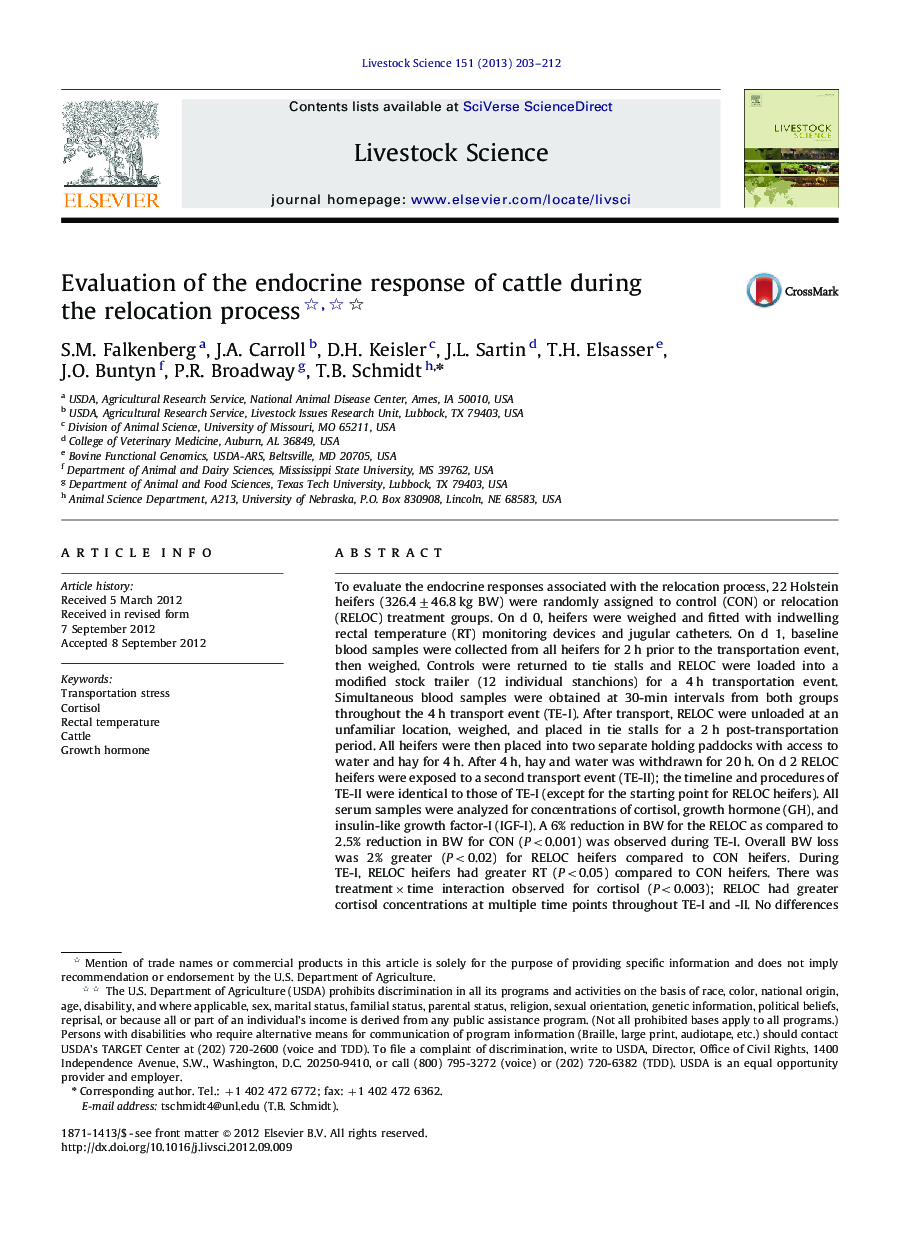| Article ID | Journal | Published Year | Pages | File Type |
|---|---|---|---|---|
| 5790455 | Livestock Science | 2013 | 10 Pages |
Abstract
To evaluate the endocrine responses associated with the relocation process, 22 Holstein heifers (326.4±46.8 kg BW) were randomly assigned to control (CON) or relocation (RELOC) treatment groups. On d 0, heifers were weighed and fitted with indwelling rectal temperature (RT) monitoring devices and jugular catheters. On d 1, baseline blood samples were collected from all heifers for 2 h prior to the transportation event, then weighed. Controls were returned to tie stalls and RELOC were loaded into a modified stock trailer (12 individual stanchions) for a 4 h transportation event. Simultaneous blood samples were obtained at 30-min intervals from both groups throughout the 4 h transport event (TE-I). After transport, RELOC were unloaded at an unfamiliar location, weighed, and placed in tie stalls for a 2 h post-transportation period. All heifers were then placed into two separate holding paddocks with access to water and hay for 4 h. After 4 h, hay and water was withdrawn for 20 h. On d 2 RELOC heifers were exposed to a second transport event (TE-II); the timeline and procedures of TE-II were identical to those of TE-I (except for the starting point for RELOC heifers). All serum samples were analyzed for concentrations of cortisol, growth hormone (GH), and insulin-like growth factor-I (IGF-I). A 6% reduction in BW for the RELOC as compared to 2.5% reduction in BW for CON (P<0.001) was observed during TE-I. Overall BW loss was 2% greater (P<0.02) for RELOC heifers compared to CON heifers. During TE-I, RELOC heifers had greater RT (P<0.05) compared to CON heifers. There was treatmentÃtime interaction observed for cortisol (P<0.003); RELOC had greater cortisol concentrations at multiple time points throughout TE-I and -II. No differences (P>0.05) in area under the curve (AUC) for cortisol were observed during TE-I. However, AUC for total cortisol during TE-II was greater (P<0.01) in the RELOC group compared to CON. There were no differences in AUC for GH between treatment groups for TE-I or -II, but a transient decline (P<0.05) within each group was observed from d 1 to d 2. There were no differences (P>0.05) in IGF-I concentrations or in AUC between the treatment groups during TE-I and -II or from d 1 to d 2. Results provide evidence that the actual processes surrounding the transportation of cattle, can elicit a stress response, as defined by increased concentrations of cortisol, RT, and BW losses.
Related Topics
Life Sciences
Agricultural and Biological Sciences
Animal Science and Zoology
Authors
S.M. Falkenberg, J.A. Carroll, D.H. Keisler, J.L. Sartin, T.H. Elsasser, J.O. Buntyn, P.R. Broadway, T.B. Schmidt,
